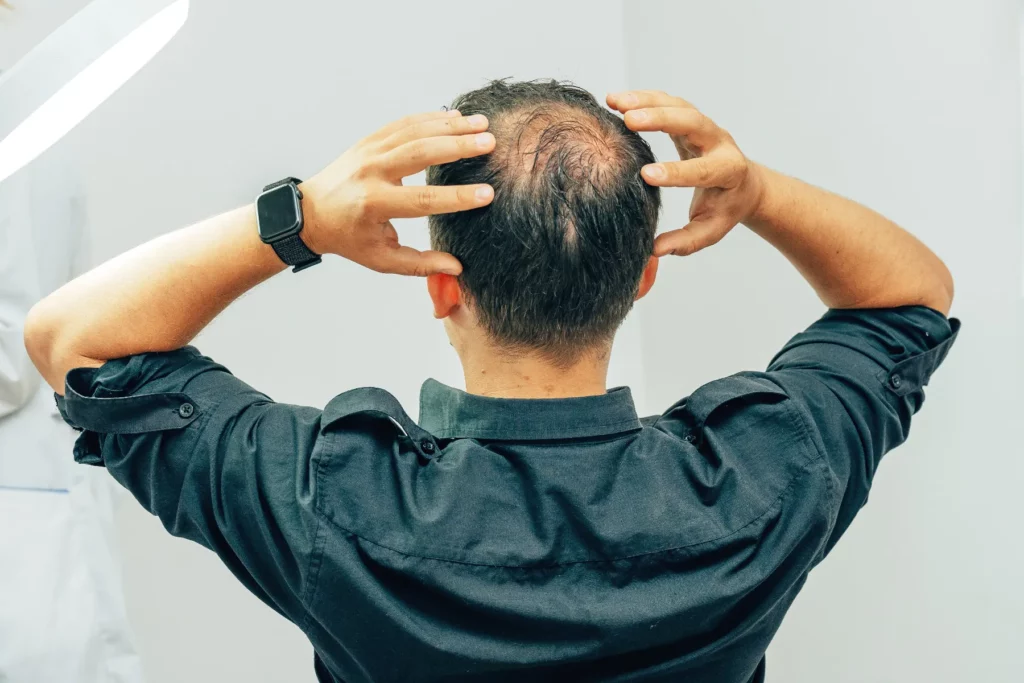Does Finasteride effectively treat hair loss?
This question has been a topic of interest for many individuals seeking a solution to their hair loss concerns. The history of Finasteride dates back to the 1980s when it was initially discovered and tested as a potential treatment for enlarged prostates. Interestingly, during these trials, medical professionals made an intriguing observation – the participants experienced an unexpected increase in hair growth while taking the medication.
This unforeseen effect prompted further investigations, leading to the approval of Finasteride as a treatment for male pattern baldness. The medication was subsequently marketed under the brand name Propecia, which gained significant popularity as a viable solution for hair loss. However, once the patent for Propecia’s marketing license expired, various pharmaceutical companies were allowed to produce and market generic versions of the medication. It is through this process that Finasteride emerged as a widely accessible option for individuals struggling with hair loss.
Today, Finasteride is commonly prescribed and used by both men and women to address hair loss concerns. It belongs to a class of medications known as 5-alpha-reductase inhibitors, which work by blocking the conversion of testosterone into dihydrotestosterone (DHT). DHT is a hormone believed to contribute to hair loss in individuals with a genetic predisposition. By inhibiting the production of DHT, Finasteride aims to slow down or even reverse the process of hair loss, promoting hair regrowth in affected individuals.
It is important to note that the effectiveness of Finasteride may vary from person to person. While many individuals have reported positive results and significant improvement in hair growth, others may experience limited or no noticeable changes. Factors such as the extent of hair loss, individual response to the medication, and adherence to the prescribed treatment regimen can all influence the outcomes.
When considering the use of Finasteride for hair loss, it is crucial to consult with a qualified healthcare professional. They can evaluate your specific situation, provide a thorough assessment of your hair loss pattern, and determine whether Finasteride is a suitable option for you. Additionally, healthcare professionals can provide guidance on the appropriate dosage, potential side effects, and any other relevant information to ensure safe and effective usage of the medication.
It is worth mentioning that like any medication, Finasteride may have potential side effects. Some individuals have reported experiencing sexual side effects such as decreased libido, erectile dysfunction, or reduced ejaculate volume while taking the medication. These side effects are generally rare, and they tend to resolve upon discontinuing the medication. Nevertheless, it is essential to be aware of these possibilities and discuss any concerns or questions with your healthcare provider.
In conclusion, Finasteride has shown promising results as a treatment for hair loss, particularly in individuals with male pattern baldness. Its discovery during the trials for enlarged prostates led to the recognition of its hair growth-promoting properties. While the effectiveness of Finasteride can vary, it remains a commonly prescribed option for those seeking to address hair loss concerns. As always, it is essential to consult with a healthcare professional to determine if Finasteride is the right choice for you and to receive proper guidance throughout the treatment process.

But how does Finasteride work exactly?
Let’s delve into its mechanism of action and explore the fascinating details. Finasteride operates through a straightforward yet significant process by inhibiting the conversion of testosterone to dihydrotestosterone (DHT). This conversion plays a pivotal role in the development of hair loss, particularly in male pattern baldness. DHT is known to cause hair follicles to miniaturize, leading to the thinning and eventual loss of hair. By impeding the conversion of testosterone to DHT, Finasteride effectively interrupts this damaging cycle.
The cessation of testosterone to DHT conversion holds tremendous potential for hair regrowth. It allows previously affected hair follicles to rejuvenate and regain their former vitality. Additionally, by blocking the formation of DHT, Finasteride serves as a preventive measure, thwarting further hair loss from occurring. The ability of Finasteride to address both existing hair loss and future hair thinning makes it a valuable treatment option for individuals struggling with male pattern baldness.
It is important to note that the production of DHT can vary from person to person due to genetic factors. Genetics play a significant role in determining an individual’s predisposition to hair loss. Some individuals may maintain a relatively full head of hair throughout their lives, while others may experience hair loss at an unexpectedly early age. Understanding the influence of genetics on DHT production can provide insights into one’s likelihood of developing male pattern baldness.
Now that we have explored the workings of Finasteride let’s discuss the proper way to take the medication.
Finasteride is typically administered in the form of a tablet, which should be taken once daily. It is crucial to consume the tablet as a whole, without crushing or breaking it, and to wash it down with water. Attempting to crush or break the tablet can result in its absorption through the skin, which can be problematic, especially if a pregnant woman comes into contact with the medication. To ensure safety, it is imperative to adhere to the prescribed method of administration.
When it comes to timing, there is no specific requirement for taking Finasteride. Whether you take it on an empty stomach, during a meal, or shortly after a meal, it does not affect the medication’s effectiveness. However, it is advisable to establish a consistent routine by taking the tablet at the same time every day. This practice fosters a habit that promotes medication adherence and ensures a regular intake, maximizing the potential benefits of Finasteride.
Now, let’s address the question of where one can purchase Finasteride.
You can conveniently acquire Finasteride online at MedsBase. It is worth noting that Finasteride is the generic form of the brand medication Propecia. Opting for the generic version can often lead to significant cost savings without compromising the medication’s quality or effectiveness. MedsBase provides a reliable platform for individuals seeking to purchase Finasteride while enjoying the benefits of affordability and accessibility.
In conclusion, Finasteride operates by inhibiting the conversion of testosterone to DHT, interrupting the cycle of hair follicle miniaturization and promoting hair regrowth. Understanding the impact of genetics on DHT production can shed light on an individual’s predisposition to male pattern baldness. When taking Finasteride, it is essential to follow the prescribed method of administration, consuming the tablet whole with water to ensure safety and effectiveness. Establishing a consistent routine for medication intake can facilitate adherence. MedsBase offers a convenient online platform to purchase Finasteride, allowing individuals to access this effective hair loss treatment while benefiting from cost savings.

How long does Finasteride take to work?
The journey to witnessing the remarkable effects of Finasteride requires a certain degree of patience and understanding. While the medication initiates its work on your scalp immediately after application, it typically takes approximately three months before the effects become visibly noticeable. During this initial period, it is not uncommon for some men to experience a temporary surge in hair shedding, which may cause momentary concern. However, this shedding process is actually a positive indication that the medication is actively working to create space for the emergence of new, stronger hair strands. So, there is no need to panic if you observe a temporary increase in hair falling out at a faster rate.
The key to unlocking the full potential of Finasteride lies in consistency and commitment to the treatment regimen. It is crucial to adhere to a continuous course of treatment without any breaks or interruptions. To accurately assess the progress and evaluate the transformative effects, it is advisable to perform a thorough comparison of your hair condition before commencing the medication and track the changes over the course of a year. By doing so, you can obtain a comprehensive understanding of the gradual improvements that occur over time. However, if after 12 months of consistent use, you have yet to witness any signs of improvement, it is highly recommended to seek guidance from your general practitioner (GP) for further evaluation and discussion to explore alternative options.
Can I take Finasteride forever?
The long-term safety and suitability of Finasteride for extended usage have been extensively investigated, providing reassuring findings. A study conducted during the Prostate Cancer Prevention Trial concluded that there is little need for concern regarding any potential long-term consequences associated with the continuous use of Finasteride for hair growth purposes. Furthermore, an in-depth study encompassing a five-year period demonstrated that individuals who diligently consumed a daily dose of Finasteride 1mg experienced not only sustained improvements in scalp hair growth but also a significant slowdown in the further progression of hair loss that would have naturally occurred without treatment.
Based on the research findings, it can be confidently asserted that Finasteride is a reliable option for long-term usage. However, it is always advisable to consult with a healthcare professional to ensure individual suitability, discuss any specific concerns or considerations, and obtain personalized advice before committing to the prolonged usage of the medication.
Does Finasteride effectively treat hair loss?
The effectiveness of Finasteride in treating hair loss is strongly supported by a wealth of scientific research, which consistently highlights its unparalleled efficacy as the most effective hair loss treatment for men. However, it is important to acknowledge that individual responses to medication can vary due to a range of factors. While Finasteride has proven highly successful for a significant number of men, it may not yield the same results for everyone.
It is worth noting that there are certain scenarios where Finasteride may not be the most suitable course of treatment. For instance, individuals who are already completely bald, suffer from specific hair loss conditions such as alopecia, or have minimal hair remaining on their scalp may not experience the desired outcomes through Finasteride treatment alone. In such cases, alternative approaches or complementary treatments might be worth exploring.
Considering these factors, it is crucial to engage in open and comprehensive discussions with healthcare professionals who can evaluate your unique circumstances, provide personalized advice, and guide you toward the most appropriate treatment options tailored to your specific hair loss concerns.
Source:
